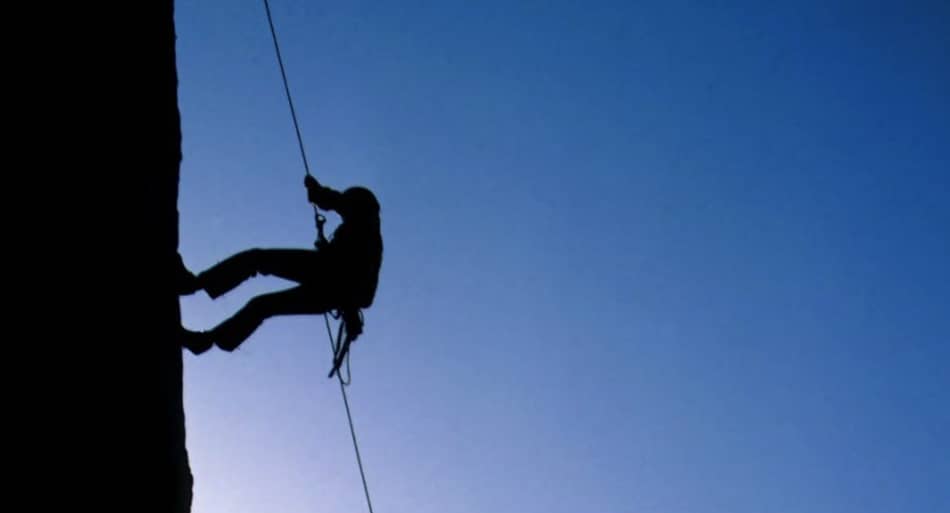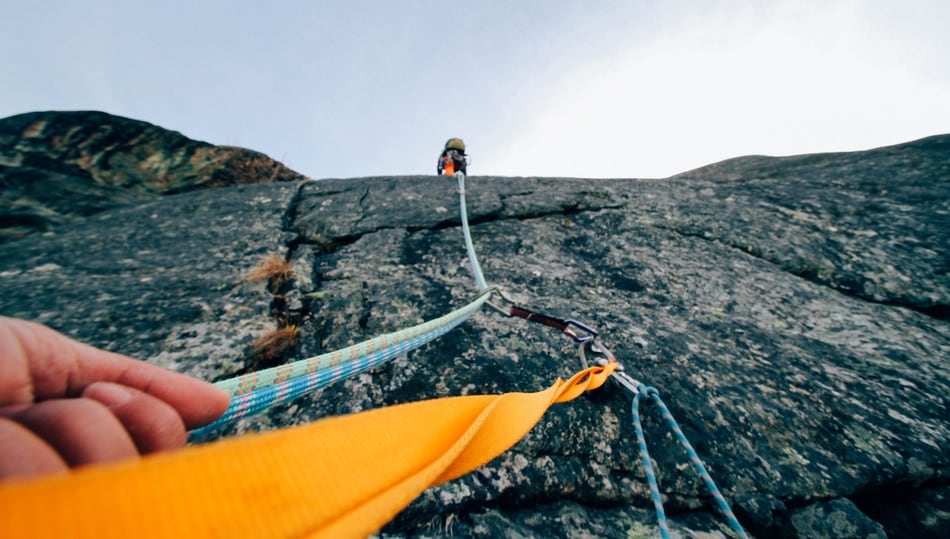
Rappelling seems like one of those things that should be simple. However, by drilling it over and over, you can ensure that your technique is flawless.
So how do you practice rappelling? By backing yourself up on a top rope belay, drilling in a controlled environment, and receiving feedback from more experience climbers, you can hone your rappelling skills without exposing yourself to unnecessary danger.
The key to practicing rappelling is to do it in such an environment that you can make mistakes without having to live with the consequences that would come with making those same mistakes under ‘real’ circumstances. To do this, take steps to remove the elements that cause you the most danger during the rappel. This will allow you to focus on learning the proper technique, as well as discovering any bad habits that you may have and working to fix them.
In the article below, I talk about why it’s important to practice rappelling and what elements are most important to practice. I then go in to more detail about the techniques outlined above as to how you can practice rappelling.
Why Practice Rappelling?
Lots of people don’t practice rappelling. Between training for your climbs, working on your technique, and dealing with all the other time-consuming activities that life can throw at you, it can be simple to feel as though you don’t need to make time to practice. Caving in to this complacency, though, can have detrimental consequences.
Though it may be surprising to find out, rappelling is actually one of the most dangerous climbing activities. This is likely due to the same type of psychology that leads to most mountaineering accidents to occur on the descent: when the hard part of the trip is over and you’ve reached your goal, it is easy to check out mentally and forget a key step in your safety protocol.

By practicing your rappels, you can ensure that every single step of the safety process— whether it’s backing up your anchor or tying a stopper knot— becomes so automatic that you never forget how to do it. This will prevent you from taking a fall as a result of a stupid mistake.
Another reason to practice your rappels is the fact that it will make it easier to rappel if you ever need to. If you’re on a multi-pitch climb and your partner becomes injured, or the weather takes a turn for the worst, the most important thing is to get to the ground quickly. You don’t have time to waste trying to remember the proper sequence to set up a double rope or attach your ATC— it needs to be automatic. Only by drilling through the same steps over and over again can you ensure this type of instantaneous muscle memory.
What Should You Practice?
By reading through Yosemite Reports and REI articles on North American climbing accidents, I’ve identified a few key areas that can cause trouble while rappelling:
- Failure to Tie Stopper Knots: Tying a stopper knot is one of those steps that is so important it needs to be automatic. Whether you’re belaying or rappelling, you must tie a knot at the end of your rope to prevent it from slipping through your belay device. Failure to do this is how Alex Honnold got injured in his lead to to free-soloing El Cap; it’s also how a Nevada Climber almost fell to her death while rappelling. Remembering to tie these knots is essential before a rappel.
- Losing Control of the Rappel: Going too quickly, using too thin of a rope, or not tying a backup knot can be detrimental to your rappel. While rappelling can be fun, and building speed is a good way to get down a route, you need to ensure that you always have the ability to stop yourself.
- Improper Technique: When rappelling, technique is everything. Making one small mistake, such as letting go of the rope, can completely compromise the safety of your rappel.
- Failure to Read Terrain: Whether it’s rockfall from above, the weather, or ensuring the you have another anchor point once you reach the end of your rappel, knowing the environment around you is essential to ensure a safe rappel.
Keep in mind that this is a far from exhaustive list. In fact, the amount of ways for a rappel to go wrong is almost endless. However, the above mistakes are some of the most common— and easily preventable— examples of rappels gone wrong that I could find in the accident reports that I read.
So, with this in mind, what area of your rappels should you practice? The most important thing is finding a routine that works for you and sticking with it. When setting up a rappel, you should follow the same sequence of moves from the moment you begin to build your anchor to when you’re safe on the ground with all of your equipment.
Building a routine and doing everything in the same order makes it that much harder for you to miss a step. It also makes the moves automatic, so that when you’re cold and tired and hungry, there’s less of a chance that you forget to tie a knot or check an anchor.
The next most important thing to do is to make sure you’re fully educated. The extent you can practice is limited by the extent of the knowledge that you have. Basic rappelling technique isn’t enough; you should know how to read terrain and rappel under a variety of circumstances. Knowing some more advanced rappels, such as tandem rappels if something happens to your climbing partner, is also useful.
Now that we know what to practice, it’s time to go in to a little more detail about how to practice.
How To Practice
Back Yourself Up On Top Rope
Having a backup belayer is one of the best ways to ensure that nothing bad is going to happen to you on rappel. Before you start to descend, have a friend or a climbing partner run another rope through your anchor, and have them spot you with a top-roping technique. They should keep the rope slack enough that it doesn’t interfere with your rappel, but tight enough that they’re ready to help should anything go wrong.

Having a top rope belay is also the best way to practice new techniques. Whether you’re using a new device, practicing with a different backup knot, or trying out an unfamiliar move, having the extra safety of being on belay will allow you to learn without needing to risk taking a dangerous fall.
Practice in a Controlled Environment
No one goes out their first day of climbing and starts projecting routes on El Cap. As in all sports, people in climbing gradually progress to more and more difficult scenarios as their skill level becomes higher and higher.
Rappelling should be no different. Your first rappel shouldn’t be a multi-pitch descent in the dark, nor should it be a fifty meter rappel through a pounding waterfall. You want to build up the level of difficulty slowly so that you’re always working within your comfort zone.
One of the best ways to do this is to practice in environments you’re familiar with. This can be a climbing gym, your local crag, or anywhere else that you feel comfortable in. I learned to rappel in my parent’s backyard, using some old roof trusses as an anchor. The benefits of learning this way are much the same as the ones listed above; it allows you to make mistakes in such a way that you can avoid any severe consequences.
Learn From More Experienced Climbers
There’s really no substitute to personal experience. No matter how many articles you read or YouTube videos you watch, it will never provide as thorough of an education as having another human being teach you will. Whether this is a friend who’s more experienced than you are or a hired guide, finding someone who has the skills to teach can be an essential step in ensuring your own safety.
In fact, I would actually encourage you to seek out professional instruction. Fully trained mountain guides have a wealth of knowledge and experience to draw upon, and will likely be able to educate you better than an old climbing friend will. There are many great tour guide companies out there who can teach you about rappelling at a fairly affordable price. Utilize them to ensure that you never find yourself in a situation you can’t get out of.
Related Questions
Do you need to practice rappelling? As mentioned in the article above, it’s essential to practice your rappels. Although rappelling seems simple, a surprisingly large amount of climbing accidents happen during the rappel. Working this skill until it becomes a habit can prevent such accidents.
Why Is Rappelling Dangerous? Rappelling is dangerous because of the situation that it places you in. When suspended tens of meters above the ground with nothing to prevent a fall except a thin piece of rope, you need to make sure that you do everything correctly.
